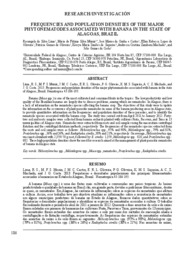Frequencies and population densities of the major phytonematodes associated with banana in the State of Alagoas, Brazil.
Frequencies and population densities of the major phytonematodes associated with banana in the State of Alagoas, Brazil.
Autoria: LIMA, R. da S.; MUNIZ, M. de F. S.; CASTRO, J. M. da C. e; OLIVEIRA, E. R. L. de; OLIVEIRA, P. G. de; SIQUEIRA, K. M. S. de; MACHADO, A. C. Z.; COSTA, J. G. da
Resumo: Banana (Musa spp.) is one of the most cultivated and consumed fruits in the tropics. The low productivity and low quality of the Brazilian bananas are largely due to disease problems, among which are nematodes. In Alagoas, there is a lack of information on the nematodes species affecting the banana crop. The objectives of this study were to update the information on the occurrence of plant-parasitic nematodes in some of the banana producing areas in Alagoas state, to provide quantitative information on the frequencies and population densities of these parasites, and to identify the nematode species associated with the banana crop. The study was carried out from April 2011 to January 2012. Fortytwo soil and roots samples were collected from banana orchards planted with cultivars Prata, Pacovan, and Terra in 13 municipalities of Alagoas state. Nematodes were extracted from roots and soil samples using the maceration-centrifugal flotation and the centrifugal-flotation methods, respectively. The frequencies of the nematodes species extracted from the roots and soil samples were as follows: Helicotylenchus spp., 95% and 98%; Meloidogyne spp., 79% and 81%; Pratylenchus spp., 36% and 26%; and Radopholus similis, 38% and 21%; respectively. On average, Helicotylenchus spp. was most abundant with 2,359/ 50 g root, followed by R. similis: 1,359, Meloidogyne spp.: 810, and Pratylenchus spp.: 682. These high population densities show the need for research aimed at the management of plant-parasitic nematodes of banana in Alagoas state.
Ano de publicação: 2013
Tipo de publicação: Artigo de periódico
Unidade: Embrapa Semiárido
Palavras-chave: Banana, Disease, Doença, Fitonematoide, Helicotylenchus, Meloidogyne, Musa, Musa spp, Nematoide, Pratylenchus, Radopholus Similis
Observações
1 - Por padrão são exibidas publicações dos últimos 20 anos. Para encontrar publicações mais antigas, configure o filtro ano de publicação, colocando o ano a partir do qual você deseja encontrar publicações. O filtro está na coluna da esquerda na busca acima.
2 - Para ler algumas publicações da Embrapa (apenas as que estão em formato ePub), é necessário ter, no celular ou computador, um desses softwares gratuitos. Sistemas Android: Google Play Livros; IOS: iBooks; Windows e Linux: software Calibre.
Acesse outras publicações
Acesse a Base de Dados da Pesquisa Agropecuária (BDPA) para consultar o acervo completo das bibliotecas da Embrapa.

